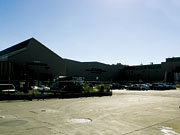
At about 450,000 sq ft, with anywhere from 45- to 55-ft ceilings, the facility is large enough to have its own climate - or three separate climates, as Chicago director of building operations Dan Carey pointed out. "Along the perimeter of the building where we have 10 heating units, the ambient temperature is comfortable, but that wasn't the case as you got into the center of the building."
There, said Carey, temperatures could be as low as 55 degrees F on any given winter day. The units did a great job of heating a 20-ft radius, but after that, the heat soon rose to the ceiling, where temperatures reached 95 degrees. From there, rooftop exhaust fans vented the heat to the outside. "Energy efficiency was a problem, and so was employee comfort. We knew we needed to fix the problem."
Spending Millions Not The Answer
As a P.E. for Commonwealth Edison, it's Chris Philbrick's job to assist customers in finding energy-saving opportunities. "The building is 80 years old," said Philbrick. "The cost of insulating it and adding more heating units would have been too high. We didn't want to spend that much money to retrofit an old building.""We had a problem, and spending millions of dollars wasn't going to save us. We knew we had enough heat, we just needed to bring it down where it would benefit employees," commented Carey.
Over the years, the city had spent thousands of dollars sending heat to an area where it had no employees working or equipment - namely the ceiling. Stratification - the natural occurrence of hot air rising to upper levels - increases the heating requirements of a facility. Energy experts figure 1 degree floor-to-ceiling temperature differential per vertical ft.
One solution Carey and Philbrick considered was installation of traditional cooling tower propeller fans, but, as Philbrick said, "the 20 hp fans weigh 2,000 lbs each. We would have needed 36 of them, which would have added to the roof load and to the facility's energy consumption." Besides that, turbulent, high-velocity airstreams dissipate quickly, giving them less impact. It was soon after their search began that Philbrick spotted an article on high-volume/low-speed fans.
Destratification and Overheating
Destratification pulls warmer air down from the ceiling and, consequently, raises the temperature of colder air at working level. Most facility managers intuitively understand that their buildings must be "overheated" to maintain a comfortable temperature for their employees. That means setting thermostats at a temperature to superheat the upper levels high enough so the heat will reach employees on the floor. Thoroughly mixing the overheated ceiling air with the cooler floor-level air allows thermostat settings to be lowered without loss of employee comfort."The facility's thermostats are at floor level," said Philbrick. "As the fans push down warm air to mix with the cold air, temperatures at the floor rise. That wasn't happening before the fans were installed. The gas-fired heating unit was running constantly. Now that we have the fans, the thermostats shut down the heating units."
Carey agreed. "There's now only a 10 degree difference between ceiling and floor temperatures," he said. "The fans look like giant helicopter blades except they move more slowly." Although the fans were installed gradually over a two-month period in 2002, from March to May, too early to predict the exact winter energy savings, Carey and Philbrick are convinced installing the fans will translate into huge energy savings. "We anticipate our fuel costs will be cut in half," added Carey.
Slowly But Surely
Big Ass Fans (Lexington, KY) come in diameters up to 24 ft. In wintertime, they're set to spin slowly. This slow rotation pushes a column of air equal to the diameter of the fan downward. When the air column hits the floor, the impact creates a deep floor jet, which radiates outward. When this jet hits a wall or partition, it's directed upward toward the ceiling where it recirculates through the fan and creates convection-like currents that gain momentum over time. In large areas without walls, the air jets created by adjacent fans act like vertical partitions to achieve the same effect.At 1/20th the horsepower of traditional fans, and weighing 1/10th of what those same fans weigh, both Philbrick and Carey were convinced that the Big Ass fans would work well. The facility now sports 19 20-ft-dia. fans. City electricians installed them, and Philbrick pointed out that mounting the fans was not difficult. "They require little or no added structural support," he said, "and the effects were noticed immediately."
Philbrick was also surprised at how well the fans work in Chicago's sweltering summers. "The Throop Building isn't air conditioned, but you can speed up the fans on hot days and they create a nice breeze. The air temperature isn't any cooler, but the sensation makes it feel like it is."
For Carey, the fans offer another critical benefit. "We had a diesel problem," he said. "Carbon monoxide and diesel fumes were hovering in a layer about 30 feet above the floor, trapped there by hot air at the upper levels. We now get eight air exchanges an hour. Our flue gas analyzers tell us the diesel fumes and carbon monoxide problem has been resolved by the fans."
"We've seen temperature fluctuations reduced. We wanted to even out temperatures and the fans are doing that beautifully," says Philbrick. "Now you can feel the heat all over the building," said Carey. He is so pleased with the fans that he's considering installing several in another fleet maintenance facility. ES
